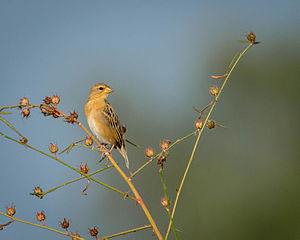Baja weaver
This article has been registered in the quality assurance biology for improvement due to formal or content-related deficiencies . This is done in order to bring the quality of the biology articles to an acceptable level. Please help improve this article! Articles that are not significantly improved can be deleted if necessary.
Read the more detailed information in the minimum requirements for biology articles .
| Baja weaver | ||||||||||||
|---|---|---|---|---|---|---|---|---|---|---|---|---|

Baja weaver ( Ploceus philippinus ), male |
||||||||||||
| Systematics | ||||||||||||
|
||||||||||||
| Scientific name | ||||||||||||
| Ploceus philippinus | ||||||||||||
| ( Linnaeus , 1766) |
The Baja weaver ( Ploceus philippinus ) is a medium-sized representative of the weaver bird family with a body length of 15 centimeters .
Appearance
The wings and back of the birds are brownish in color with thick black stripes. The beak and legs are brown. The head and chest of the male are yellowish in color, while these are brown in the female.
distribution and habitat
This species occurs from Pakistan via India to southwest China, all over Southeast Asia and south to Sumatra and Djawa. There it inhabits savannas, forest edges, grain fields, but also occurs in mountains such as the Himalayas up to an altitude of 1400 meters.
Way of life
These very sociable birds live in large flocks with up to 200 individuals and roam the savannah landscapes in search of food such as plant seeds, insects and other small invertebrates, and rarely also flower nectar from erythrina trees and caper bushes . The populations that occur in the Himalayas move into the valleys in autumn, the other populations remain true to their location all year round.
Reproduction
The males of this species build bag-shaped nests in acacia, dalbergia and prosopis trees, 3 meters above the ground. These colony nests of palm leaves and blades of grass can contain up to 200 individuals. The upper part is round and a long entry tube connects to the bottom. The inside is lined with mud. Since the females are very picky, the male builds 2 to 5 such nests. The male mates with several females. When mating has occurred, the female lays 3 to 5 eggs in them and incubates them for up to 2 weeks. The female alone supplies the chicks with insect larvae, spiders and various plant seeds. After 15 to 17 days, the young birds leave the nest and join the colony. The males only get the adult color at the age of 2 years, the females after one year. The first brood of the offspring does not take place until the second year of life.
Danger
Due to its further distribution and that no endangerments are known for this species, the IUCN classifies this species as ( Least Concern ) not endangered.
Source
- Jiří Felix (eds.), Květoslav Hísek: Asian fauna in color. Translated from the Czech by Ingeborg Šestáková. Karl Müller Verlag, Erlangen 1989, pp. 77-78.
- The great world empire of the animals. Planet Media AG, Zug 1992, ISBN 3-8247-8614-1 , pp. 388, 389.
- Christopher M. Perrins (Ed.): The FSVO encyclopedia birds of the world. Translated from the English by Einhard Bezzel. BLV, Munich / Vienna / Zurich 2004, ISBN 978-3-405-16682-3 , pp. 594-595 (title of the English original edition: The New Encyclopedia Of Birds. Oxford University Press, Oxford 2003).
Web links
- Ploceus philippinus inthe IUCN Red List of Threatened Species 2015.3. Listed by: BirdLife International, 2012. Retrieved October 4, 2015.

